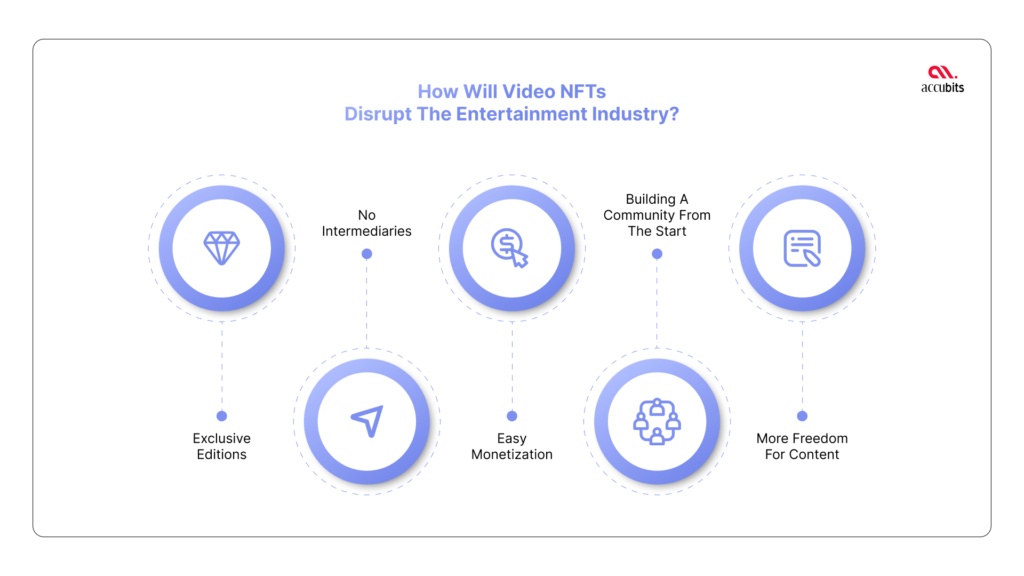83% of online users consume content in video form, according to Statista. A video titled Crossroads by Beeple, a graphic designer, was bought for $67,000 and resold on the secondary marketplace for $6.6 million. Grimes made $5 million in 48 hours by selling copies of her “Earth” and “Mars” videos. In short, video NFTs are climbing up just as much as the entire NFT realm is taking over the digital art industry. Despite being misunderstood with the question of “what’s the point when someone else can just download the video from youtube?”, Video NFT proves that it is not entirely about the content but the ownership rights. Read ahead to discover how monetizing video content as NFTs might be the best way to make money as a creator in 2022.
- What is an NFT?
- What is a video NFT?
- Why should content creators start building their own video NFTs?
- How will video NFTs disrupt the entertainment industry?
- Steps to create a video NFT
- Bottom line
What is an NFT?
NFT is the abbreviation of the non-fungible token, where non-fungible means non-interchangeable. NFTs exist as unique entities and cannot be interchanged with one another. They are digital assets and contain art, video, audio, and more. Users can trade NFTs over something which has a similar value. For example, NFTs can be bought using crypto or fiat currency.
What is a video NFT?
When a video is minted as an NFT, it is called a video NFT or a video token. Any picture with motion elements can be made into an NFT and traded just like an image or GIF NFT. They are mainly bought using cryptocurrency and are encoded with the underlying blockchain. These NFTs bring digital scarcity to the video industry, driving the demand for ownership and opening a new income stream for creators.
To understand how a video NFT works, let’s first get to the basics of how NFTs work. NFTs, like crypto, work on a blockchain, and Ethereum typically holds most of the NFTs, but other blockchains like Solana, Tezos, and Flow also support NFTs. In addition to ETH cryptocurrency (ERC20), Ethereum also supports NFTs (ERC721). The blockchain stores the digital database of the NFT while maintaining a transparent, secure, and decentralized record of all the transactions.
Now, videos minted as NFTs works the same way as any NFT. The original video is minted as an NFT, and the blockchain holds it. The NFT can be traded on the blockchain, and the transaction records can reveal the current owner and trace back to who the original owner or the creator was.
Owning a video NFT is not about the video at all. It is about ownership rights to the original video version in a particular blockchain. When a video NFT is bought, it is publicly confirmed that the buyer owns the rights to that NFT in the blockchain. As the demand increases, the NFT rights can be sold to another person.
Prerna Gupta, a serial entrepreneur, launched a music video NFT platform titled Mysterious with most female and non-binary artists like Teebs, MNDSGN, Prefuse73, Mount Kimbie, and Shigeto. Mysterious hopes to empower experimental artists with a strong fan base and earn more through NFTs. The music video NFTs also gives fans access to intimate gatherings with artists, exclusive servers, and secret drops.
Why should content creators start building their own video NFTs?
NFTs allow artists to monetize their work. Content creators can earn a percentage profit every time the NFT is resold so that the artists get credits no matter how much the demand for the NFT increases.
With video NFTs, content creators can display and sell their content to a global audience without an intermediary. Kings of Leon, a musician, is selling his albums as NFTs. Digital art content creator Pak recently sold a video art NFT, “Metarift,” for $906,709 through Makersplace. It was also his most expensive individual piece.
Related article: Applications of NFTs in Digital Entertainment
How will video NFTs disrupt the entertainment industry?
Video NFTs disrupt the entertainment industry by helping content creators be autonomous. These NFTs also decentralize the media supply chain and aid in easy monetizing all while building a healthy community of investors.

Avoiding intermediaries with video NFT
NFTs are already transforming the entertainment industry by making its economy decentralized, and preventing intermediaries. This is especially helpful for indie artists who would not want to spend on content distribution. Some indie artists like Yaeji, Toro y Moi, and Flying Lotus have already jumped on the NFT train.
Mainstream artists including Weezer, the Weeknd, and Snoop Dogg have been boosting themselves out of the pandemic rut with NFTs. Even the classics have jumped on the Gen Z trend. Director Quentin Tarantino has released uncut scenes of Pulp Fiction as NFTs.
Building a community from the start
By releasing NFTs of the posters, trailers, and teasers, moviemakers can create a fanbase before the release. Some artists have also exploited this as a way of fundraising. Jennifer Esposito is funding her first film Fresh Kills, with NFTs and a public offering to sell the film shares.
Exclusive editions
With NFTs, exclusive editions with first looks and bloopers can be released and sold. Demand can be driven by special versions of the films or music. Curren$y, a rapper from New Orleans, released a set of NFTs, each with different tiers of perks. It included low-rider cars, exclusive access to his new album, and a real-life meeting with the artist in the future.
Easy monetization through video NFT
The competition on entertainment platforms like Youtube has skyrocketed, and only a few get to monetize their creations successfully. Most YouTubers earn from brand deals and ads. Video NFTs can enable new income streams, especially for smaller content creators. Youtube recently announced NFTs and Web 3.0 as new creator tools. Following the trail, the Indian short-form video-creating platform Chingari launched an NFT marketplace where Bollywood celebrities can monetize their videos as NFTs.
Adam Mosseri, the head of Instagram, announced that the platform would test NFT adoption with a few creators in the U.S. Mosseri also said that there would be no fee for posting digital collectibles on Instagram. Ethereum and Polygon, with support for Flow and Solana, will be the blockchains for NFTs on Instagram at the launch. Mark Zuckerberg revealed that Meta would be working on bringing NFTs and 3D NFTs that can be posted in the feed or as stories on Instagram.
More freedom for content
Blockchain offers decentralized storage for art NFTs. Because of this, artists can easily sell their content, and users can pass it on without confiding to the restrictions of any platform. Creators can bypass the censorship rules of individual platforms and monetize content that Youtube or Instagram may not allow.
Note: Moral rules of content creation apply to NFTs as well. More content freedom does not mean offensive, derogatory and misleading content will be allowed. Such content will be penalized.
Steps to create a video NFT
To create a video NFT from start to finish, creators could follow the below-given steps as they are common for most NFT marketplaces.
1. Create and set up your account and digital wallet to own verified cryptocurrency.
2. Attach your crypto wallet to an NFT marketplace with which you have registered. A few well-known NFT marketplaces include OpenSea.io, Rarible, and Foundation.
3. You have to create a collection for your NFTs. For example, in opensea.io, you will create a collection and create a new item where you can upload your video NFT.
4. Describe your video NFT and remember these descriptions will help your NFT to be found by buyers.
5. Sell your NFTs after paying the activation fee.
If you are planning to launch a Video NFT Marketplace, make sure to consult with a reliable NFT Marketplace development company to do a feasibility analysis for creating video NFTs for your project.
Bottom line
The idea of ownership on the internet has drastically changed in this age of decentralization. Efforts to promote scarcity and demand have been the prime motive of this economy. One way of doing that is through NFTs. it helps in putting values over the ownership rights of digital assets. Recently, videos have also entered the stream of NFTs, emphasizing content creators especially. Out of the various kinds of NFTs, video NFTs are emerging as a new means for monetizing, distributing, and popularizing video content.
Related article: Where will NFTs pop up next?


